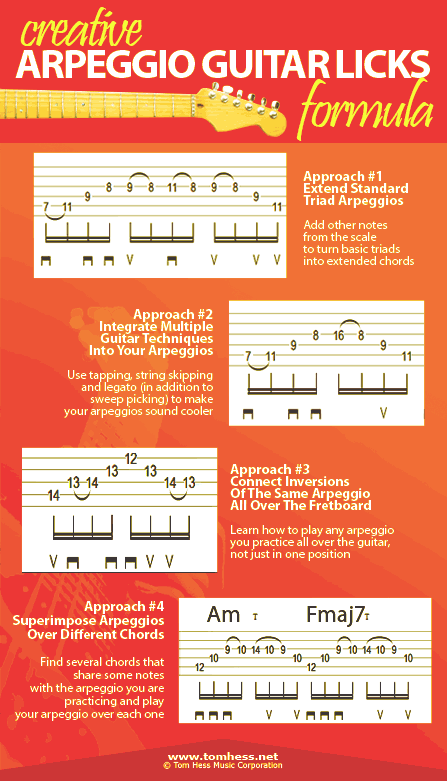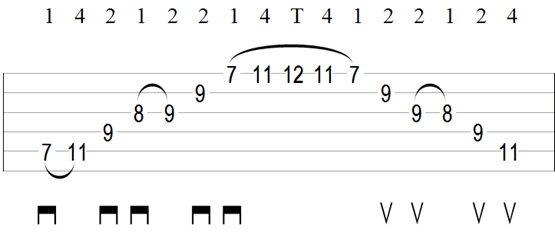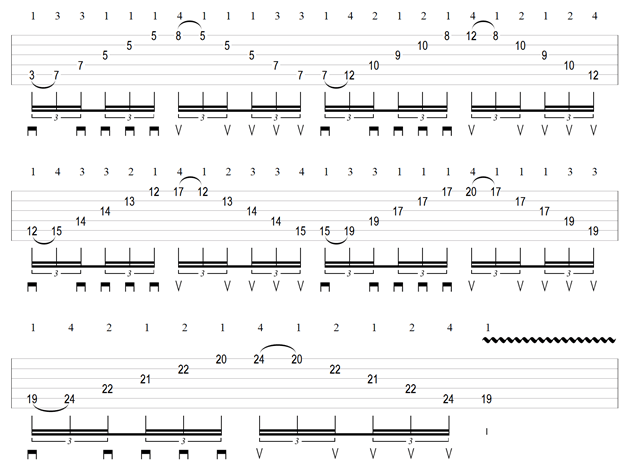Transform Boring Arpeggios Into Highly Creative Sweep Picking Guitar Licks
By Tom Hess
Do you want to make your sweep picking licks more creative? Do the following: focus more on creatively applying the arpeggio patterns you already know into music rather than seeking out as many new patterns as you can find. This is not very hard to do and you can quickly turn the arpeggio licks you already know into killer guitar licks using the following four methods:

Approach One: Expand Basic Triad Arpeggios
There is a lot more at your disposal than just the common major, minor or diminished arpeggios. You can also use additional notes to make things more interesting by adding them to basic triads to create extended sweep picking shapes.
Check out the video below to understand more about how this is done:
Check out the next half of this free sweep picking video to learn even cooler sweep picking shapes to add to your guitar playing style.
Approach Two: Using Arpeggios Together With Different Guitar Techniques
Your arpeggios will sound much more musical when you combine sweep picking with one or more additional guitar techniques. This gives your guitar phrasing much more variety and interest whenever you use arpeggios (particularly when used with the previously mentioned concept of expanding triad arpeggios with other notes).
You can enhance arpeggios by combining them with legato, tapping, string skipping, speed picking as well as any other guitar technique.
For example, here is a major seventh arpeggio that was made by adding notes to a basic major triad while using hammer ons, pull offs and tapping technique:

To learn a lot more sweep picking patterns like this, see this video about playing awesome sweep picking guitar licks.
Approach Three: Combine The Shapes Of Different Arpeggio/Chord Inversions All Over The Guitar Fretboard
As soon as you learn a new arpeggio shape, start using it in all areas of the fretboard in order to connecting all the shapes of the arpeggio together. This will both help improve your overall guitar technique AND give you more creative freedom while improvising or thinking of new guitar licks.
Here is an example that utilizes an A minor arpeggio pattern all over the fretboard, and combines different arpeggio patterns together:

By learning how to combine arpeggio shapes together you become a better overall guitar player and improve your fretboard visualization skills. This is important for becoming more expressive as a guitarist, improviser and songwriter. In addition, it helps you quickly remember the notes of new music you just learned with detailed accuracy.
Notice: Fretboard visualization is a specific skill that has to be practiced and improved, just like anything else you’ve learned on guitar. To make fast progress with this skill, you’ll need to track your progress on a consistent basis. Check out this tool for how to make a lot faster progress on guitar to discover how to do this very effectively.
Approach Four: Play Arpeggios Over A Variety Of Different Chords
In addition to knowing HOW you should play arpeggios, you also need to practice changing WHEN you play arpeggios. What does this mean? The easiest and way to play and arpeggio is to play it over a chord of the same name (for example: a C major arpeggio played over a C major chord). Of course, you can play the same C major arpeggio over countless other chords to create unique and expressive results, for example: F major, G major, D minor, or E minor.
Check out this example that compares two chords: B minor and G major.
The B minor arpeggio (or chord) has these three notes: B, D and F#. The G major chord contains notes: G, B, D. Observe that two of these notes (B and D) are shared by both chords. So as you play a B minor arpeggio over G major, you’re essentially playing two common notes (B and D) and one unshared note (F#). This causes your ears to hear is a G major 7 chord (made of notes G B D F#).
So as you change when the arpeggio is used (over what chords), you have the power to make any sweep picking lick feel completely different. Listen to this example of an A minor arpeggio that is being applied over the chords: A minor, F major, C major, D minor, E minor.
Begin using these ideas in your general guitar playing and you will open the door to a new level of creativity within your sweep picking arpeggio phrasing. To learn even more about developing better sweep picking technique, watch this free video about playing sweep picking arpeggio guitar licks.
About The Author:
Tom Hess is a highly successful guitar teacher, songwriter and a pro guitarist. He uses the best online guitar lessons to train guitar players to reach their musical goals. Go to tomhess.net to get more guitar playing resources, guitar playing eBooks, and to read more guitar playing articles.
Post new comment
Please Register or Login to post new comment.